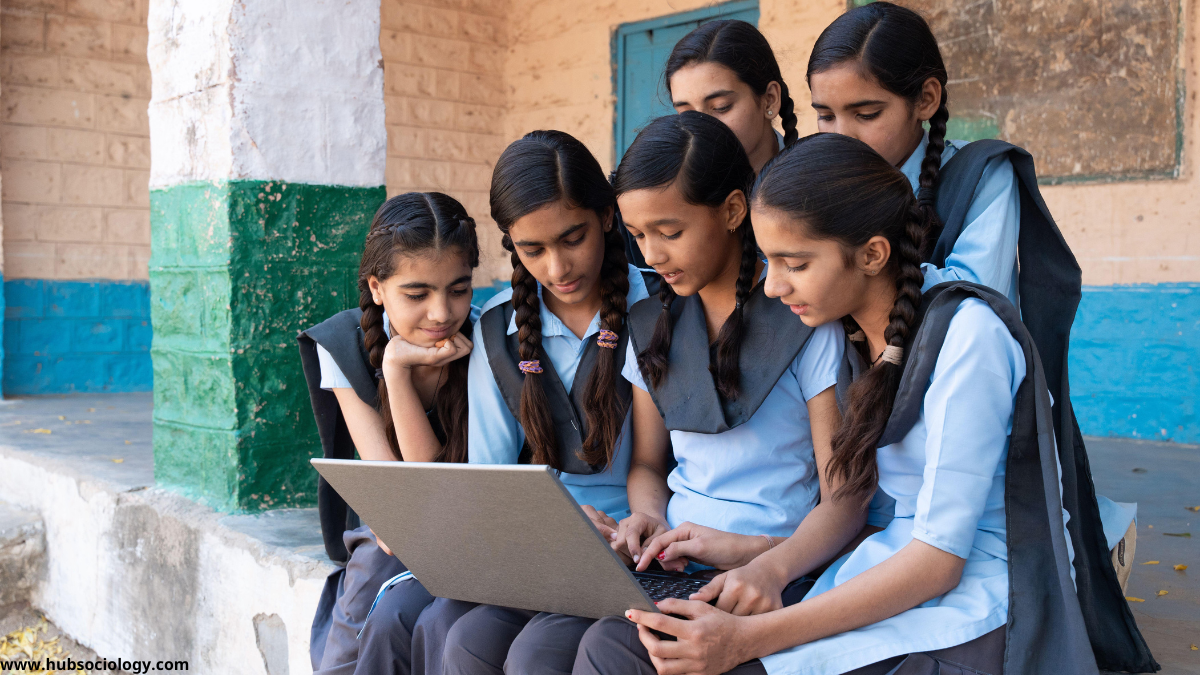Introduction
The digital divide refers to the gap between individuals, households, businesses, and geographic areas at different socioeconomic levels regarding access to information and communication technologies (ICTs) and the use of the Internet. In India, despite rapid technological advancements, this divide remains a significant sociological concern. The digital divide exacerbates existing social inequalities, reinforcing disparities in education, employment, healthcare, and civic participation.
From a sociological perspective, the digital divide is not merely a technological issue but a reflection of deeper structural inequalities based on class, caste, gender, region, and rural-urban divides. This article examines the digital divide in India through a sociological lens, analyzing its causes, consequences, and potential solutions.

Understanding the Digital Divide
The digital divide can be categorized into three levels:
- Access Divide – Disparities in actual physical access to digital gadgets and the Internet are known as the “access divide.”
- Usage Divide – Variations in how individuals use digital technologies.
- Quality of Use Divide – Differences in the ability to use digital tools effectively for socio-economic benefits.
In India, these divides intersect with existing social hierarchies, creating a complex web of exclusion.
Causes of the Digital Divide in India
1. Economic Inequality
Access to digital technology is closely tied to income levels. Affluent households can afford smartphones, computers, and high-speed internet, while marginalized groups struggle with basic connectivity. According to the India Inequality Report 2022, the top 20% of Indians own more digital resources than the remaining 80%.
2. Rural-Urban Disparity
Urban areas have better digital infrastructure, including 4G networks and broadband services, whereas rural regions face connectivity issues. Only over 38% of rural families have internet connectivity, compared to 72% of urban households, according to the Telecom Regulatory Authority of India (TRAI).
3. Gender Gap
Patriarchal norms restrict women’s access to digital devices. In India, only 33% of women utilize the internet, compared to 67% of men, according to a UNICEF research from 2021. Social restrictions, lack of digital literacy, and safety concerns further widen this gap.
4. Caste and Social Exclusion
Lower castes and tribal communities often face systemic exclusion from digital resources. Many Dalit and Adivasi households lack access to digital education and e-governance services, perpetuating their marginalization.
5. Educational Barriers
Digital literacy is essential for effective internet use. However, India’s education system does not uniformly incorporate digital training. Children from low-income families, especially in government schools, lack exposure to digital learning tools.
6. Linguistic and Cultural Factors
Most digital content is in English or Hindi, excluding non-native speakers. Regional language users face difficulties in accessing meaningful online resources, limiting their participation in the digital economy.
Consequences of the Digital Divide
1. Educational Inequality
The shift to online education during COVID-19 highlighted disparities. Students without devices or internet access were left behind, worsening dropout rates among marginalized groups.
2. Employment and Economic Exclusion
The digital economy favors those with access to technology. Job opportunities in e-commerce, freelancing, and IT remain inaccessible to digitally excluded populations, reinforcing poverty cycles.
3. Healthcare Disparities
Telemedicine and digital health services are growing, but rural and low-income groups lack access, leading to unequal healthcare outcomes.
4. Political and Civic Marginalization
E-governance initiatives like Digital India aim to improve service delivery, but the digitally excluded cannot benefit. This weakens democratic participation and access to welfare schemes.
5. Reinforcement of Social Hierarchies
The digital divide reinforces existing inequalities based on caste, class, and gender, creating a “digital elite” while leaving others further behind.
Government Initiatives and Their Limitations
To close the digital divide, the Indian government has started a number of initiatives:
- Digital India (2015) – The goal of Digital India (2015) is to increase digital literacy and offer broadband connectivity to rural areas.
- Pradhan Mantri Gramin Digital Saksharta Abhiyan (PMGDISHA) – Rural digital literacy is the main focus of the Pradhan Mantri Gramin Digital Saksharta Abhiyan (PMGDISHA).
- National Digital Literacy Mission (NDLM) – Trains individuals in basic digital skills.

However, these initiatives face challenges:
- Implementation gaps – Corruption and bureaucratic delays hinder effective rollout.
- Lack of infrastructure – Many villages still lack electricity and internet towers.
- Low awareness – Marginalized groups are often unaware of these schemes.
Sociological Solutions to Bridge the Divide
1. Inclusive Policy Making
Policies must address intersectional inequalities—caste, gender, and regional disparities—rather than adopting a one-size-fits-all approach.
2. Community-Based Digital Literacy Programs
Local NGOs and SHGs (Self-Help Groups) can train women and marginalized communities in digital skills, ensuring contextual learning.
3. Affordable Internet and Devices
Subsidized internet plans and low-cost devices (like the Aakash tablet) can improve accessibility.
4. Multilingual and Culturally Relevant Content
Expanding digital content in regional languages will enhance inclusivity.
5. Public-Private Partnerships (PPP)
Collaborations between the government, tech companies (like Google and Microsoft), and civil society can scale digital inclusion efforts.
6. Gender-Sensitive Approaches
The gender gap can be closed by providing women with digital skills and safe online environments.
Conclusion
India’s digital divide is a societal problem with deep roots in structural inequality rather than only a technological one. Without addressing the structural barriers—economic disparity, caste discrimination, gender biases, and rural-urban gaps—technological advancements will only benefit a privileged few.

A multi-dimensional approach involving policy reforms, grassroots interventions, and corporate responsibility is essential to ensure equitable digital access. Bridging the digital divide is not merely about connectivity; it is about social justice, empowerment, and inclusive development in an increasingly digital world.
Do you like this this Article ? You Can follow as on :-
Facebook – https://www.facebook.com/hubsociology
Whatsapp Channel – https://whatsapp.com/channel/0029Vb6D8vGKWEKpJpu5QP0O
Gmail – hubsociology@gmail.com
Topic Related Questions
5-Mark Questions (Short Answer Type)
- Define the digital divide and explain its types.
- How does economic inequality contribute to the digital divide in India?
- What is the role of caste in digital exclusion in India?
- How has the COVID-19 pandemic highlighted India’s digital divide?
- List three government initiatives aimed at reducing the digital divide in India.
- Why is there a gender gap in digital access in India?
- How does the rural-urban divide affect internet accessibility in India?
- What are the consequences of the digital divide on education in India?
- Explain the concept of the “usage divide” in the context of India.
- How does language act as a barrier in India’s digital inclusion?
10-Mark Questions (Detailed Answer Type)
- Discuss the sociological factors contributing to the digital divide in India. (Class, Caste, Gender, Region)
- Analyze the impact of the digital divide on healthcare access in rural India.
- Evaluate the effectiveness of the Digital India program in bridging the digital divide.
- How does the digital divide reinforce existing social inequalities in India?
- Explain the challenges faced by marginalized communities in accessing digital services in India.
- Discuss the role of digital literacy in reducing the digital divide.
- How does the digital divide affect employment opportunities in India?
- “The digital divide is not just about access but also about quality of use.” Explain with reference to India.
- What measures can be taken to reduce the gender digital divide in India?
- Critically examine the role of public-private partnerships in addressing India’s digital divide.
15-Mark Questions (Essay/Long Answer Type)
- “The digital divide in India is a reflection of deep-rooted structural inequalities.” Discuss this statement from a sociological perspective.
- Analyze the digital divide in India with reference to caste, class, and gender disparities. Suggest measures to bridge this gap.
- Examine the impact of the digital divide on education in India, especially during and after the COVID-19 pandemic.
- Critically evaluate the government’s policies and initiatives to bridge the digital-divide in India. What more needs to be done?
- How does the digital divide affect democratic participation and access to governance in India?
- Discuss the role of civil society and NGOs in addressing the digital-divide in rural India.
- “The digital-divide is not just an urban-rural issue but also an intersectional one.” Elaborate with examples from India.
- What are the long-term consequences of the digital-divide on India’s socio-economic development?
- How can India ensure inclusive digital growth to prevent further marginalization of vulnerable groups?
- Compare the digital-divide in India with that of another developing country. What lessons can India learn?

1 thought on “Digital Divide in India: A Sociological Concern”